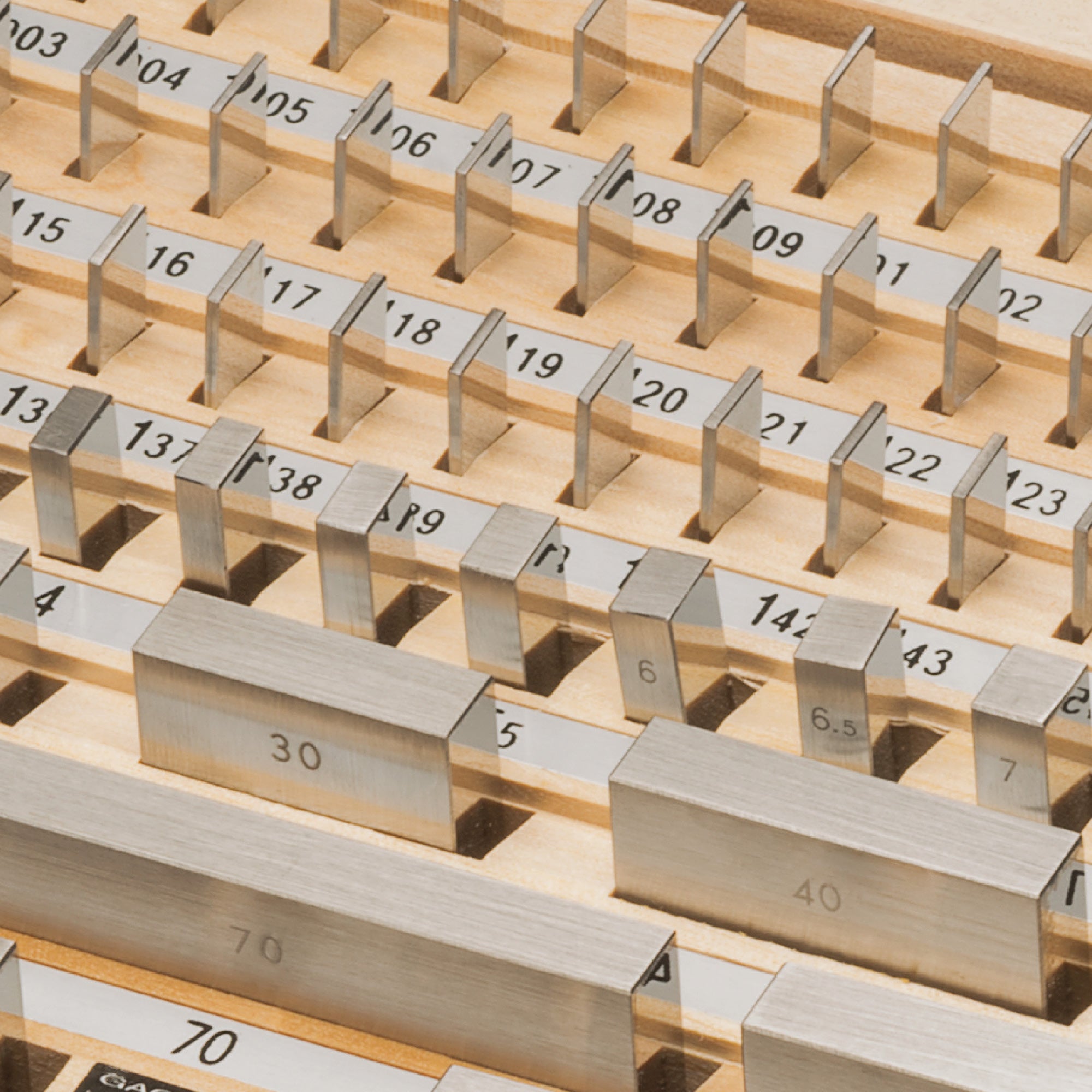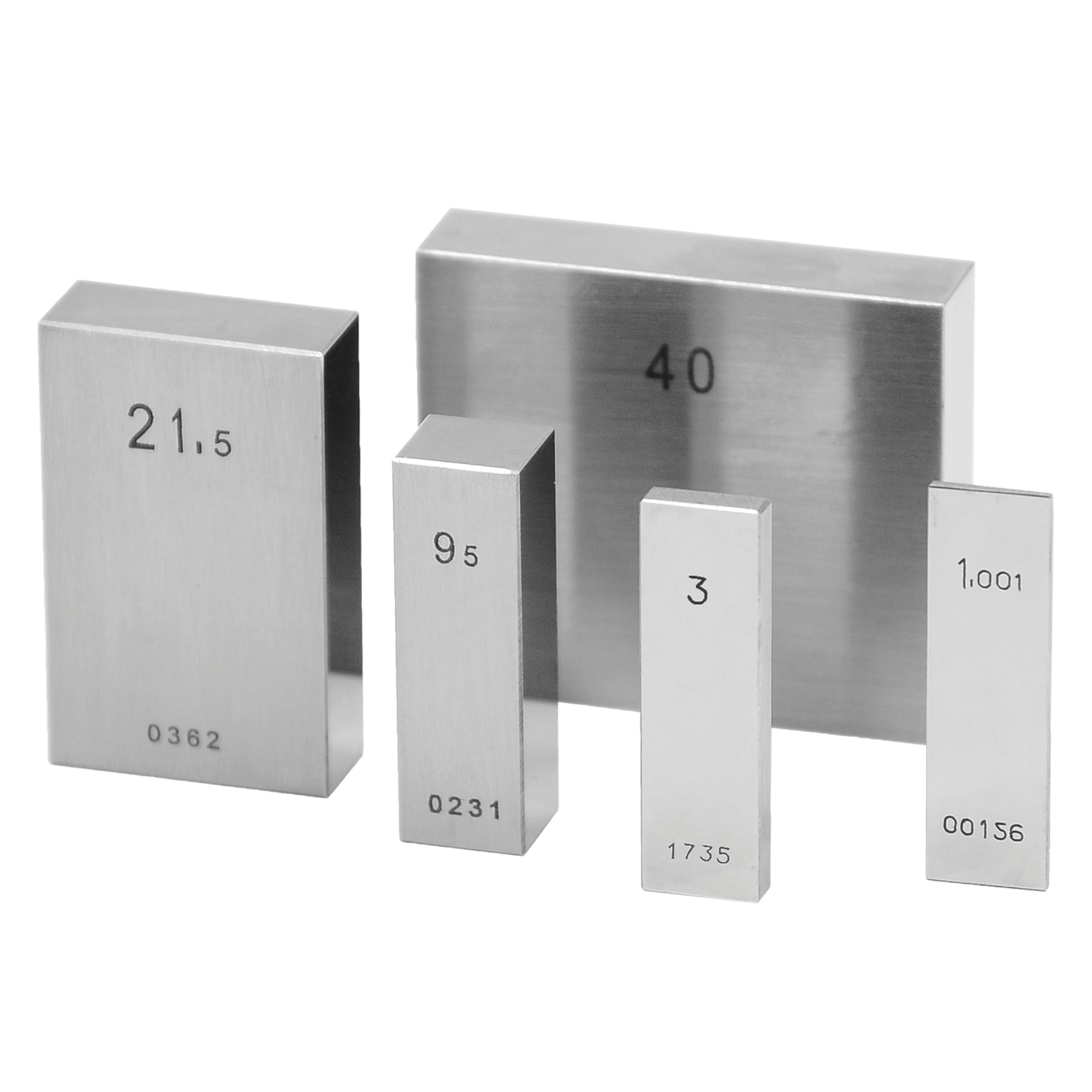Definition
Gauge blocks (parallel gauge blocks) are high-precision manufactured, rectangular measuring bodies
with precisely defined lengths. In metrology and quality assurance, they are used to calibrate measuring instruments, adjust machines, and perform comparison/adjustment measurements. All specifications are defined in DIN 861 and DIN EN ISO 3650.
Terminology and labeling

Gauge blocks with a length ≥ 10 mm are labelled on one side with the nominal size and the serial number (and manufacturer if applicable).

Material
Gauge blocks are available in a variety of materials – steel, ceramic, and carbide are common. The table below compares the different properties.
| Characteristic | Steel | Ceramics | Carbide |
|---|---|---|---|
| Coefficient of linear expansion | 11.5 ⋅ 10 -6 / K | 9.3 ⋅ 10 -6 / K | 4.5 ⋅ 10 -6 / K |
| Vickers hardness approx. | 800 | 1350 | 1600 |
| Thermal conductivity | ●●○○○ | ●●●●● | ●●●○○ |
| Wear resistance | ●●●○○ | ●●●●● | ●●●●○ |
| Starting properties | ●●●●● | ●●●○○ | ●●●●● |
| Corrosion resistance | ●●○○○ | ●●●●● | ●●●●○ |
| Long-term stability | ●●●○○ | ●●●●○ | ●●●●● |
Accuracy classes
Gauge blocks are manufactured in various accuracy classes that indicate how precisely the gauge is manufactured. In addition to the most common classes 2, 1, and 0, there is class K (calibration class), which is primarily used for reference measurements.
The higher the number, the greater the permissible deviation from the nominal dimension. The choice of accuracy class depends on the intended use and the required tolerances in the respective measuring process.
Gen. 2
Mostly used as “working standards” at test stations in production areas and for setting measuring tools and devices.
Gen. 1
Used for setting and calibrating gauges and measuring instruments in measuring rooms and at test stations in high-precision manufacturing areas.
Gen. 0
Use for high-precision test equipment monitoring and calibration in air-conditioned measuring rooms.
Tolerances according to DIN 861
| Length mm |
Gen. 0 µm |
Gen. 1 µm |
Gen. 2 µm |
|---|---|---|---|
| 0 - 10 | ± 0.12 | ± 0.20 | ± 0.45 |
| 10 - 25 | ± 0.14 | ± 0.30 | ± 0.60 |
| 25 - 50 | ± 0.20 | ± 0.40 | ± 0.80 |
| 50 - 75 | ± 0.20 | ± 0.50 | ± 1.00 |
| 75-100 | ± 0.30 | ± 0.60 | ± 1.20 |
Instructions for use
When using gauge blocks, there are some important instructions to follow to maintain their high accuracy and avoid measurement errors.
Before use
- Use in a thermally stable environment (ideally 20°C)
- Touch as briefly as possible or work with gloves - body heat of the hands can lead to length expansion
- Wipe/clean with a soft cloth; gauge blocks must be absolutely clean and free of grease when used
- Do not use alcohol or benzine for cleaning, as this may cause corrosion.
After use
- Rust protection treatment with corrosion protection oil
- Storage in a case/box
Push

For larger gauge block combinations, a gauge block connector can be used. Gauge blocks 125 mm and over have two holes for secure attachment to the holder.

Application examples


Setting for stop turning on the lathe

Adjusting the depth stop on the drill
Do you have further questions about gauge blocks or would you like to know which one is right for you? Contact us .







